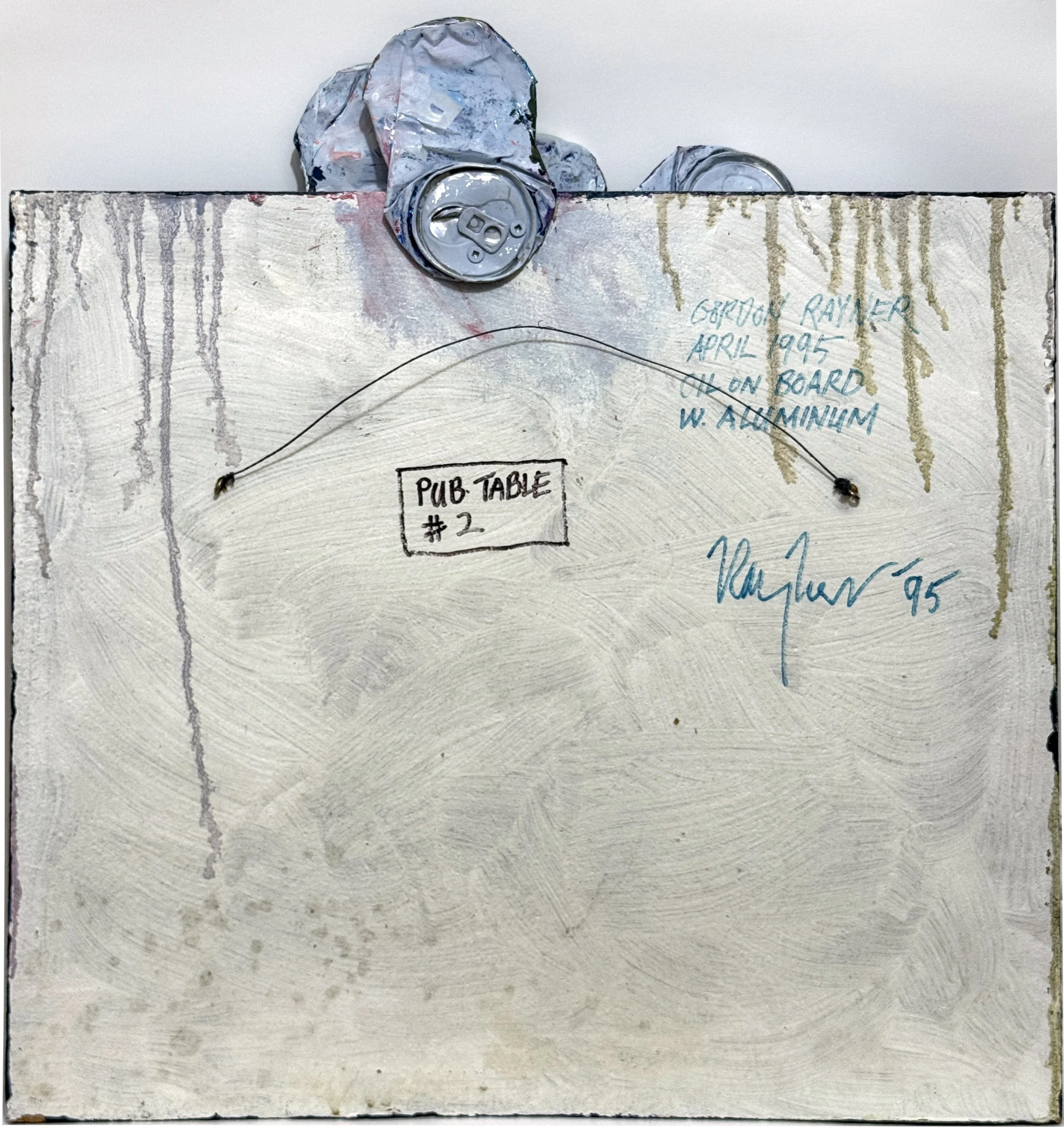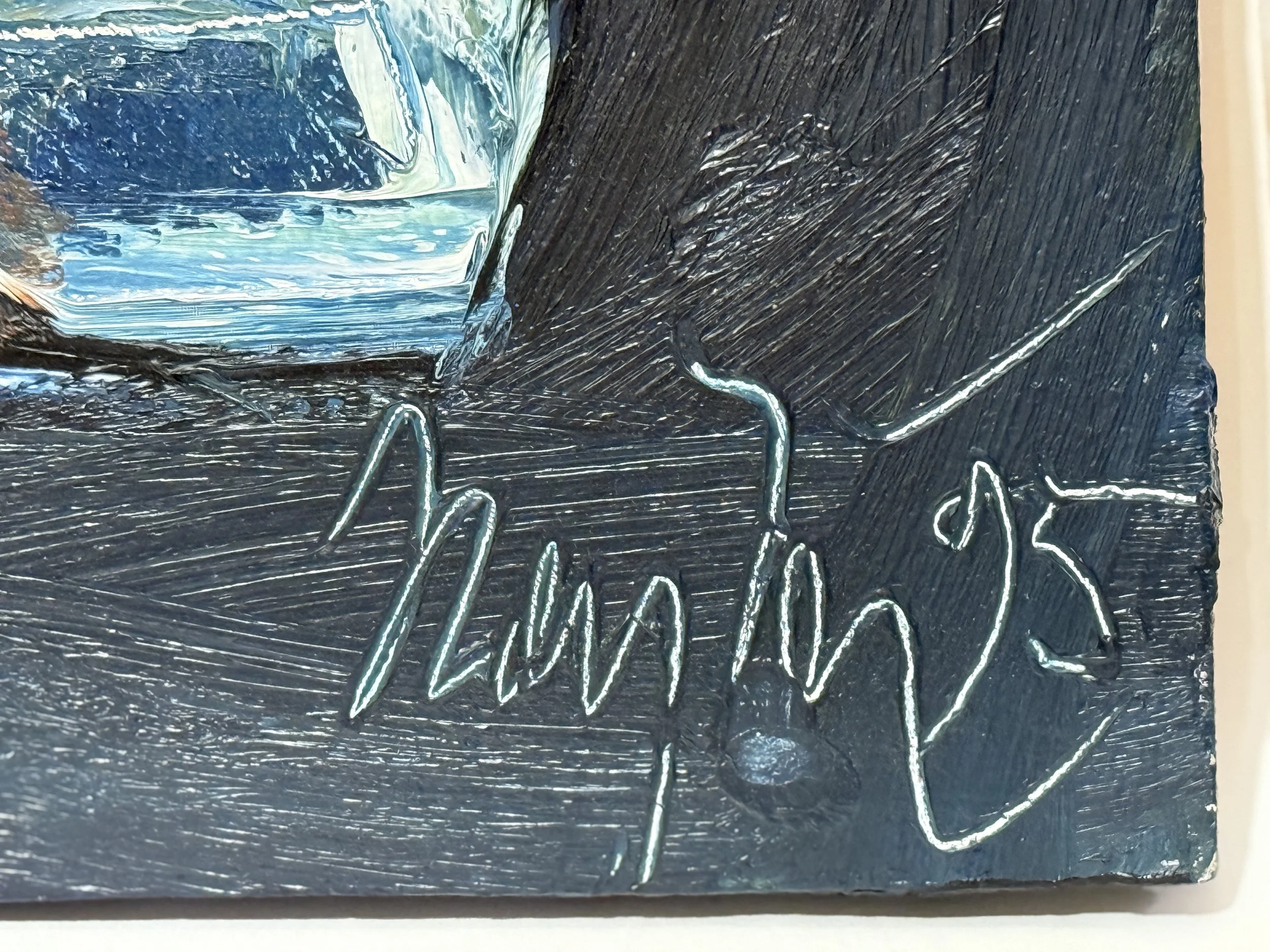Gordon Rayner
(1935–2010)
Artist: Gordon Rayner (1935 - 2010)
Title: Pub Table #2, 1995
Media: oil paint, wood, aluminum (pop cans)
Size: 21” x 20” x 3”
Notes: signed and dated lower right, the painting incorporates found objects
Verso: signed and dated, titled, name of artist, medium, date
CAN $8,500.00
Provenance:
Mann Collection, St. Catharines
purchased from the Moore Gallery, Toronto
exhibited by the artist at Moore Gallery in 1995
Gordon Rayner’s Pub Table #2 exemplifies his fearless exploration of everyday subjects transformed through painterly intensity. Rendered with thick, visceral brushwork and impasto surfaces, the crushed cans become both sculptural and symbolic—standing in for the rhythm of modern life and the collision between consumerism and creativity. In Pub Table #2, Rayner transforms the ordinary into the extraordinary—where a simple tabletop scene becomes a meditation on colour, perception, and the alchemy of paint itself.
Offered at CAD 8,500, Pub Table #2 (21″ × 20″ × 3″) is a vibrant and texturally rich example of Gordon Rayner’s acclaimed “pop can” series. In this work, Rayner transforms a simple, discarded object into a bold study—an embodiment of his experimentation and physical approach to artmaking. The piece captures his hallmark blend of abstraction and materiality, qualities that define his place among Canada’s most innovative postwar artists linking him to the Isaacs Gallery circle of artists such as Michael Snow and Joyce Wieland
John Mann, an entrepreneur at heart, was deeply drawn to Gordon Rayner’s fearless spirit of experimentation. He admired Rayner’s willingness to take risks, to break conventions, and to explore new directions without hesitation—qualities that mirrored John’s own approach to business and life. The Pop Can painting hung proudly by the front of his home, part of a personal gallery that served as a daily reminder of the value of courage, creativity, and the bold pursuit of new ideas.
Collector’s Note: Rayner’s auction history typically ranges between CAD 2,500 and 25,000, with larger acrylic and mixed-media works achieving the upper end of that spectrum. Retail listings for comparable mid-sized pieces fall around CAD 8,000–9,500, placing Pub Table #2 comfortably within market expectations. Given its strong provenance, engaging subject, and connection to one of Rayner’s most distinctive periods, this work represents an accessible and compelling acquisition for collectors of Canadian modern art. The current owners are open to reasonable offers.
ABOUT THE ARTIST
Gordon Rayner (June 14, 1935 – September 26, 2010)
Gordon Rayner was a seminal Canadian abstract expressionist painter celebrated for his primal, physically immediate approach to painting, extraordinary use of color, and continual innovation that embraced everything from neo-Dada found-object constructions to richly expressionistic landscapes and later figurative works. Born and based primarily in Toronto, Rayner's artistic journey spanned over five decades, marked by restless curiosity and a refusal to settle into any single style.
Rayner first learned to paint under the tutelage of his father, a commercial artist and weekend painter, and his father's close friend, Jack Bush, a notable Canadian artist himself. Rayner spent 17 years in commercial art, working at Wookey, Bush and Winter, before fully committing to painting, inspired by an exhibition of the Painters Eleven in 1955 and particularly the work of William Ronald, as well as visits to Toronto’s Hart House Gallery and the Buffalo AKG Art Museum where he encountered major American abstract painters like Willem de Kooning.
In the late 1950s and early 1960s, influenced by the Toronto neo-Dada movement, Rayner’s work combined found materials with painting, producing highly original constructions that disrupted traditional boundaries between sculpture and two-dimensional art. This period showcased his experimental spirit and helped establish his reputation as a fearless innovator within the Canadian art scene. A pivotal phase began in 1966 when Rayner focused intensely on the landscapes of Magnetawan, a remote area north of Toronto near Muskoka. This place became a recurring source of inspiration and a laboratory for his expressive experimentation with materials and technique. His paintings from this period are dramatic, intuitive reinterpretations of the northern landscape, often employing thick, gestural brushwork and occasionally found objects, reflecting a dialogue with nature that transcended mere replication.
Rayner exhibited prominently with Toronto’s Isaacs Gallery, alongside peers such as Michael Snow, Joyce Wieland, John Meredith, and Graham Coughtry, situating him within an influential circle of Canadian modernist artists. In the 1980s, his focus shifted toward figurative work, notably exploring the human form with a spiritual and psychological depth. His figurative series culminated in works like the "Oaxaca Suite," painted during extended stays in Oaxaca, Mexico, in the early 1990s; these pieces meld his earlier expressionistic vigor with nuanced realism portrayed in inventive self-portraits and scenes charged with inner life.
Rayner’s legacy is rich and complex, spanning from neo-Dada to abstract and figurative expressionism with a hallmark obsession with materiality and color. His contributions earned him public commissions such as the "Tempo" mural at Toronto’s St. Clair West station and a touring retrospective organized by the Robert McLaughlin Gallery in 1979, which traveled to twelve galleries across Canada. His works are housed in major collections worldwide, including the National Gallery of Canada, the Montreal Museum of Fine Art, the Art Gallery of Ontario, the Museum of Modern Art in New York, and the Philadelphia Museum of Art.
Known as the “carpenter” of contemporary Canadian art for his integration of found objects into his expressive paintings, Gordon Rayner’s oeuvre crackles with a raw energy and inventive spirit, embodying an unending quest for formal and conceptual discovery. His impact continues to resonate in Canadian modern art, recognized for his fearless creative evolution and dynamic fusion of the abstract and the figurative. Restlessly creative and forever unwilling to repeat himself, Rayner spent his final decades continuing to push the limits of painting. His late self-portraits—lucid, unflinching, and profoundly human—stand as testaments to his lifelong curiosity and courage. He was working on a new canvas when he passed away suddenly at his Toronto home in 2010.
Gordon Rayner leaves behind a legacy of fearless exploration and material daring. His art continues to resonate for its raw emotional power and its celebration of the unknown—works that, in his own words, remind us that “what matters, but risk.”
"Gordon Rayner’s work crackles with raw energy, blending fierce material experimentation with intuitive, emotionally charged painting to create art that feels both timeless and urgently alive."
"The Art of Gord Rayner" hosted by Ron Moore (1985)
Discover the bold vision of Gordon Rayner—one of Canada’s most original and uncompromising painters—in this rare 1985 documentary, The Art of Gord Rayner, hosted by Ron Moore and recently digitized for the Peel Region archives. This compelling film offers an intimate look into Rayner’s early influences, from his father’s commercial art studio to the magnetic pull of Toronto’s vibrant avant-garde scene, tracing how he evolved into a key figure in Canadian abstract expressionism.



